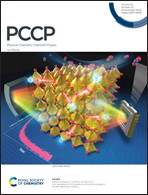Interplay between local structure, vibrational and electronic properties on CuO under pressure
Abstract
The electronic and local structural properties of CuO under pressure have been investigated by means of X-ray absorption spectroscopy (XAS) at Cu K edge and ab initio calculations, up to 17 GPa. The crystal structure of CuO consists of Cu motifs within CuO4 square planar units and two elongated apical Cu–O bonds. The CuO4 square planar units are stable in the studied pressure range, with Cu–O distances that are approximately constant up to 5 GPa, and then decrease slightly up to 17 GPa. In contrast, the elongated Cu–O apical distances decrease continuously with pressure in the studied range. An anomalous increase of the mean square relative displacement (EXAFS Debye–Waller, σ2) of the elongated Cu–O path is observed from 5 GPa up to 13 GPa, when a drastic reduction takes place in σ2. This is interpreted in terms of local dynamic disorder along the apical Cu–O path. At higher pressures (P > 13 GPa), the local structure of Cu2+ changes from a 4-fold square planar to a 4+2 Jahn–Teller distorted octahedral ion. We interpret these results in terms of the tendency of the Cu2+ ion to form favorable interactions with the apical O atoms. Also, the decrease in Cu–O apical distance caused by compression softens the normal mode associated with the out-of-plane Cu movement. CuO is predicted to have an anomalous rise in permittivity with pressure as well as modest piezoelectricity in the 5–13 GPa pressure range. In addition, the near edge features in our XAS experiment show a discontinuity and a change of tendency at 5 GPa. For P < 5 GPa the evolution of the edge shoulder is ascribed to purely electronic effects which also affect the charge transfer integral. This is linked to a charge migration from the Cu to O, but also to an increase of the energy band gap, which show a change of tendency occurring also at 5 GPa.

- This article is part of the themed collection: 2020 PCCP HOT Articles


 Please wait while we load your content...
Please wait while we load your content...